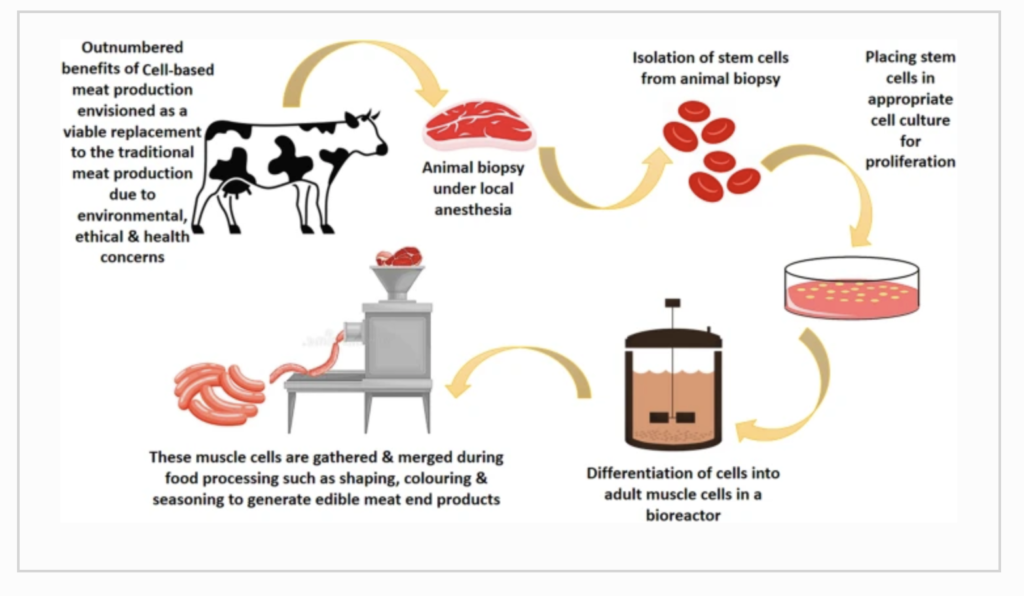The future of cultured meat
- hellomarwadi
- 0
- on Sep 01, 2022
Cultured meat, sometimes called lab-grown, clean, or cultivated meat, is grown in a lab from a few animal cells. It’s real meat, but it doesn’t require animals to be slaughtered the way traditional meat does. This production method eliminates the need to raise and farm animals for food. Cultivated meat is made of the same cell types arranged in the same or similar structure as animal tissues, thus replicating the sensory and nutritional profiles of conventional meat. This kind of technology differs from plant-based meat as it’s actually made from animal cells, whereas, plant-based meat is produced from plants and doesn’t contain any animal product. Cell-based meat is also more realistic than plant-based meat and more ethical and environmentally-friendly than animal meat.

In response to a growing population and rising food demand, the food industry has come up with a wide array of alterations, innovations, and possibilities for making meat in vitro. To make lab-grown meat, scientists take stem cells, the so-called building block cells, from an animal. They bathe the cells in a liquid containing nutrients to help them duplicate and put them into a bioreactor, a lab device for growing organisms. Cultured meat grown in vitro from animal cells has the potential to address many of the ethical, environmental, and public health issues associated with conventional meat production.
The concept of cultured meat was introduced to wider audiences by Jason Matheny in the early 2000s after he co-authored a paper on cultured meat production and created New Harvest, the world’s first nonprofit organization dedicated to in-vitro meat research. In 2005, the Dutch government funded two research projects on cultured meat, and the medical researcher, Mark Post, and Google’s cofounder, Sergei Brin, partnered to accelerate its development. The first scientific publication on cultured meat occurred in 2008, and the number of publications since 2013 has increased considerably. In 2008, the Food Research Institute of Norway organized a conference on cultured meat. Public visibility increased widely after a television show in 2013 in London where Post cooked cultured meat and two journalists publicly tasted it, declaring that “it was close to meat”. The first commercialization of a cultured meat product occurred in December 2020 in a restaurant in Singapore.
Since robust scientific arguments are lacking on these aspects, there is no consensus on the health and nutritional qualities of “cultured meat” for human consumption and on its potential low environmental impact. In addition, many issues related to the market, legislation, ethics and consumer perception remain to be addressed.
Two nonprofit organizations, New Harvest, and later, the Good Food Institute, have been key players in supporting the research and development (R&D) of cultured meat. Much of the advanced work in the field has been (and continues to be) conducted within startups.
Cultured meat/ Cell-based meat companies
Aleph Farms
Balletic Foods
Biftek
BioBQ
BlueNalu
Clear Meat
Finless Foods
Future Meat Technologies
GOOD Meat
GOURMEY
Ivy Farm Technologies
MeaTech
MeaTech 3D
Meatable
Memphis Meats
Micro Meat
Mirai Foods
Mosa Meat
Mosa Meat
Multus Media
Shiok Meats
SuperMeat
UPSIDE Foods
Reference:
Bryant CJ. Culture, meat, and cultured meat. J Anim Sci. 2020 Aug 1;98(8):skaa172.
Treich N. Cultured Meat: Promises and Challenges. Environ Resour Econ (Dordr). 2021;79(1):33-61.
Benny, A., Pandi, K. & Upadhyay, R. Techniques, challenges and future prospects for cell-based meat. Food Sci Biotechnol 31, 1225–1242 (2022).